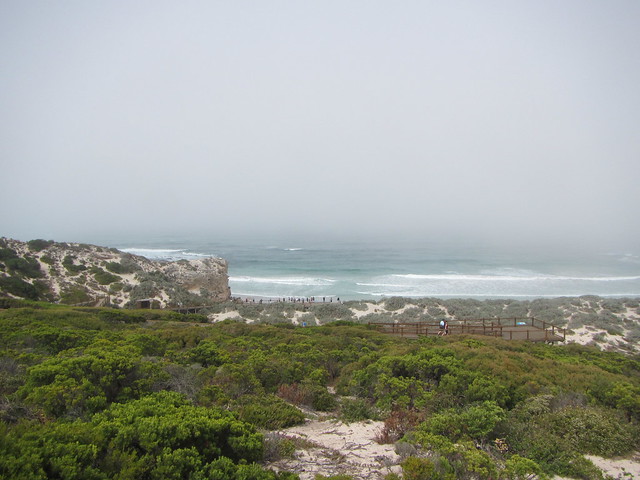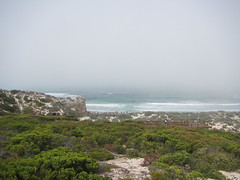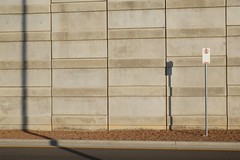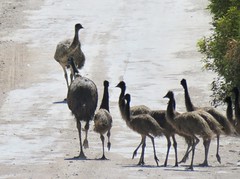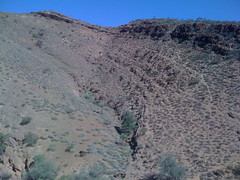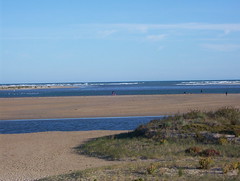South Australia
South Australia (commonly abbreviated as SA) is a state in the southern central part of Australia. It covers some of the most arid parts of the country. With a total land area of , it is the fourth-largest of Australia's states and territories by area, and second smallest state by population. It has a total of 1.8 million people. Its population is the second most highly centralised in Australia, after Western Australia, with more than 77 percent of South Australians living in the capital Adelaide, or its environs. Other population centres in the state are relatively small; Mount Gambier, the second-largest centre, has a population of 33,233.
South Australia shares borders with all of the other mainland states, as well as the Northern Territory; it is bordered to the west by Western Australia, to the north by the Northern Territory, to the north-east by Queensland, to the east by New South Wales, to the south-east by Victoria, and to the south by the Great Australian Bight. The state comprises less than 8 percent of the Australian population and ranks fifth in population among the six states and two territories. The majority of its people reside in greater Metropolitan Adelaide. Most of the remainder are settled in fertile areas along the south-eastern coast and River Murray. The state's colonial origins are unique in Australia as a freely settled, planned British province, rather than as a convict settlement. Colonial government commenced on 28 December 1836, when the members of the council were sworn in near the Old Gum Tree.
As with the rest of the continent, the region has a long history of human occupation by numerous tribes and languages. The South Australian Company established a temporary settlement at Kingscote, Kangaroo Island, on 26 July 1836, five months before Adelaide was founded. The guiding principle behind settlement was that of systematic colonisation, a theory espoused by Edward Gibbon Wakefield that was later employed by the New Zealand Company. The goal was to establish the province as a centre of civilisation for free immigrants, promising civil liberties and religious tolerance. Although its history has been marked by periods of economic hardship, South Australia has remained politically innovative and culturally vibrant. Today, it is known for its fine wine and numerous cultural festivals. The state's economy is dominated by the agricultural, manufacturing and mining industries.
History
Evidence of human activity in South Australia dates back as far as 20,000 years, with flint mining activity and rock art in the Koonalda Cave on the Nullarbor Plain. In addition wooden spears and tools were made in an area now covered in peat bog in the South East. Kangaroo Island was inhabited long before the island was cut off by rising sea levels. According to mitochondrial DNA research, Aboriginal people reached Eyre Peninsula 49,000-45,000 years ago from both the east (clockwise, along the coast, from northern Australia) and the west (anti-clockwise).
The first recorded European sighting of the South Australian coast was in 1627 when the Dutch ship the Gulden Zeepaert, captained by François Thijssen, examined and mapped a section of the coastline as far east as the Nuyts Archipelago. Thijssen named the whole of the country eastward of the Leeuwin "Nuyts Land", after a distinguished passenger on board; the Hon. Pieter Nuyts, one of the Councillors of India.
The coastline of South Australia was first mapped by Matthew Flinders and Nicolas Baudin in 1802, excepting the inlet later named the Port Adelaide River which was first discovered in 1831 by Captain Collet Barker and later accurately charted in 1836–37 by Colonel William Light, leader of the South Australian Colonization Commissioners' 'First Expedition' and first Surveyor-General of South Australia.
The land which now forms the state of South Australia was claimed for Britain in 1788 as part of the colony of New South Wales. Although the new colony included almost two-thirds of the continent, early settlements were all on the eastern coast and only a few intrepid explorers ventured this far west. It took more than forty years before any serious proposal to establish settlements in the south-western portion of New South Wales were put forward.
On 15 August 1834, the British Parliament passed the South Australia Act 1834 (Foundation Act), which empowered His Majesty to erect and establish a province or provinces in southern Australia. The act stated that the land between 132° and 141° east longitude and from 26° south latitude to the southern ocean would be allotted to the colony, and it would be convict-free.
In contrast to the rest of Australia, terra nullius did not apply to the new province. The Letters Patent, which used the enabling provisions of the South Australia Act 1834 to fix the boundaries of the Province of South Australia, provided that "nothing in those our Letters Patent shall affect or be construed to affect the rights of any Aboriginal Natives of the said Province to the actual occupation and enjoyment in their own Persons or in the Persons of their Descendants of any Lands therein now actually occupied or enjoyed by such Natives." Although the patent guaranteed land rights under force of law for the indigenous inhabitants, it was ignored by the South Australian Company authorities and squatters. Despite strong reference to the rights of the native population in the initial proclamation by the Governor, there were many conflicts and deaths in the Australian Frontier Wars in South Australia.
Survey was required before settlement of the province, and the Colonization Commissioners for South Australia appointed William Light as the leader of its 'First Expedition', tasked with examining 1500 miles of the South Australian coastline and selecting the best site for the capital, and with then planning and surveying the site of the city into one-acre Town Sections and its surrounds into 134-acre Country Sections.
Eager to commence the establishment of their whale and seal fisheries, the South Australian Company sought, and obtained, the Commissioners' permission to send Company ships to South Australia, in advance of the surveys and ahead of the Commissioners' colonists.
The company's settlement of seven vessels and 636 people was temporarily made at Kingscote on Kangaroo Island, until the official site of the capital was selected by William Light, where the City of Adelaide is currently located. The first immigrants arrived at Holdfast Bay (near the present day Glenelg) in November 1836.
The commencement of colonial government was proclaimed on 28 December 1836, now known as Proclamation Day.
South Australia is the only Australian state to have never received British convicts. Another free settlement, Swan River colony was established in 1829 but Western Australia later sought convict labour, and in 1849 Western Australia was formally constituted as a penal colony. Although South Australia was constituted such that convicts could never be transported to the Province, some emancipated or escaped convicts or expirees made their own way there, both prior to 1836, or later, and may have constituted 1–2% of the early population.
The plan for the province was that it would be an experiment in reform, addressing the problems perceived in British society. There was to be religious freedom and no established religion. Sales of land to colonists created an Emigration Fund to pay the costs of transferring a poor young labouring population to South Australia. In early 1838 the colonists became concerned after it was reported that convicts who had escaped from the eastern states may make their way to South Australia. The South Australia Police was formed in April 1838 to protect the community and enforce government regulations. Their principal role was to run the first temporary gaol, a two-room hut.
The current flag of South Australia was adopted on 13 January 1904, and is a British blue ensign defaced with the state badge. The badge is described as a piping shrike with wings outstretched on a yellow disc. The state badge is believed to have been designed by Robert Craig of Adelaide's School of Design.
Geography
The terrain consists largely of arid and semi-arid rangelands, with several low mountain ranges. The most important (but not tallest) is the Mount Lofty-Flinders Ranges system, which extends north about from Cape Jervis to the northern end of Lake Torrens. The highest point in the state is not in those ranges; Ngarutjaranya is in the Musgrave Ranges in the extreme northwest of the state.
The south-western portion of the state consists of the sparsely inhabited Nullarbor Plain, fronted by the cliffs of the Great Australian Bight. Features of the coast include Spencer Gulf and the Eyre and Yorke Peninsulas that surround it. The Temperate Grassland of South Australia is situated to the east of Gulf St Vincent.
The principal industries and exports of South Australia are wheat, wine and wool. More than half of Australia's wines are produced in the South Australian wine regions which principally include Barossa Valley, Clare Valley, McLaren Vale, Coonawarra, the Riverland and the Adelaide Hills. See South Australian wine.
South Australian boundaries
South Australia has boundaries with every other Australian mainland state and territory except the Australian Capital Territory and the Jervis Bay Territory.The Western Australia border has a history involving the South Australian government astronomer, G.F. Dodwell, and the Western Australian Government Astronomer, H.B. Curlewis, marking the border on the ground in the 1920s.
In 1863, that part of New South Wales to the north of South Australia was annexed to South Australia, by letters patent, as the "Northern Territory of South Australia", which became shortened to the Northern Territory on 6 July 1863. The Northern Territory was handed to the federal government in 1911 and became a separate territory.
Accordi…
Looking for places related to South Australia?
Those are other destinations to find places related to South Australia:
